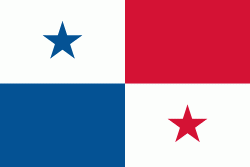Isla de Coiba (Isla de Coiba)
Coiba is the largest island in Central America, with an area of 503 km2, off the Pacific coast of the Panamanian province of Chiriquí. It is part of the Tolé District of that province.
Coiba separated from continental Panama about 12,000 to 18,000 years ago when sea levels rose. Plants and animals on the new island became isolated from mainland populations and over the millennia most animals have diverged in appearance and behaviour from their mainland counterparts. The island is home to many endemic subspecies, including the Coiba Island howler monkey, the Coiba agouti and the Coiba spinetail.
Coiba was home to the Coiba Cacique Indians until about 1560, when they were conquered by the Spanish and forced into slavery.
In 1919 a penal colony was built on the island and during the years that Panama was under the dictatorships of Omar Torrijos and Manuel Noriega, the prison on Coiba was a feared place with a reputation for brutal conditions, extreme tortures, executions and political murder. Nobody knows exactly how many people were killed in the prison during this period, but sources claim that the number could be close to three hundred. As such, the island was avoided by locals, and other than the prison, was completely undeveloped.
After the prison was closed down in 2004, the island's pristine condition made it ideal as a reserve. It is now said that the prison is haunted by the ghosts of prisoners. One story is that a guard was chasing a prisoner, but the prisoner was a ghost. The guard was so scared that he shot himself. It is also one of the last places in Central America where the scarlet macaw can be found in large numbers in the wild. The island is about 75% forested with a large fraction standing ancient forest. Coiba Island is home to rare flora and fauna found only on the island. The island also harbours tree species that have long disappeared from the mainland due to deforestation and overharvesting.
Coiba separated from continental Panama about 12,000 to 18,000 years ago when sea levels rose. Plants and animals on the new island became isolated from mainland populations and over the millennia most animals have diverged in appearance and behaviour from their mainland counterparts. The island is home to many endemic subspecies, including the Coiba Island howler monkey, the Coiba agouti and the Coiba spinetail.
Coiba was home to the Coiba Cacique Indians until about 1560, when they were conquered by the Spanish and forced into slavery.
In 1919 a penal colony was built on the island and during the years that Panama was under the dictatorships of Omar Torrijos and Manuel Noriega, the prison on Coiba was a feared place with a reputation for brutal conditions, extreme tortures, executions and political murder. Nobody knows exactly how many people were killed in the prison during this period, but sources claim that the number could be close to three hundred. As such, the island was avoided by locals, and other than the prison, was completely undeveloped.
After the prison was closed down in 2004, the island's pristine condition made it ideal as a reserve. It is now said that the prison is haunted by the ghosts of prisoners. One story is that a guard was chasing a prisoner, but the prisoner was a ghost. The guard was so scared that he shot himself. It is also one of the last places in Central America where the scarlet macaw can be found in large numbers in the wild. The island is about 75% forested with a large fraction standing ancient forest. Coiba Island is home to rare flora and fauna found only on the island. The island also harbours tree species that have long disappeared from the mainland due to deforestation and overharvesting.
Map - Isla de Coiba (Isla de Coiba)
Map
Country - Panama
 |
 |
| Flag of Panama | |
Panama was inhabited by indigenous tribes before Spanish colonists arrived in the 16th century. It broke away from Spain in 1821 and joined the Republic of Gran Colombia, a union of Nueva Granada, Ecuador, and Venezuela. After Gran Colombia dissolved in 1831, Panama and Nueva Granada eventually became the Republic of Colombia. With the backing of the United States, Panama seceded from Colombia in 1903, allowing the construction of the Panama Canal to be completed by the United States Army Corps of Engineers between 1904 and 1914. The 1977 Torrijos–Carter Treaties agreed to transfer the canal from the United States to Panama on December 31, 1999. The surrounding territory was first returned in 1979.
Currency / Language
| ISO | Currency | Symbol | Significant figures |
|---|---|---|---|
| PAB | Panamanian balboa | B/ | 2 |
| USD | United States dollar | $ | 2 |
| ISO | Language |
|---|---|
| EN | English language |
| ES | Spanish language |















